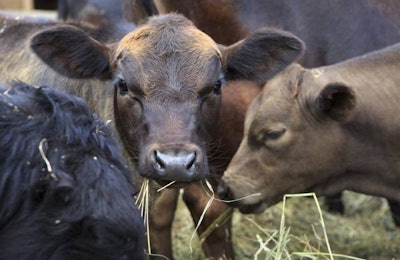
The U.S. Food and Drug Administration (FDA) has approved a drug for beef cattle that lowers the ammonia gas released as a byproduct of the animals’ waste. This is the first time the FDA has approved a drug that reduces gas emissions from an animal or its waste.
Experior, developed by Elanco Animal Health, works by partially reducing ammonia gas emissions from manure in enclosed settings. The medicated feed additive is administered to beef steers and heifers fed in confinement for slaughter during the last 14 to 91 days on feed.
“Elanco is proud of this pioneering effort to address key customer needs to help reduce environmental impact,” said Aaron Schacht, executive vice president, innovation, regulatory and business development of Elanco Animal Health, in a statement. “This innovation is an important new tool that should enable beef producers to care for their cattle and the environment.”
Ammonia emission concerns
Ammonia gas emissions can come from many sources, including the manure of beef cattle. Ammonia gas emissions are a concern because they have been implicated in atmospheric haze and noxious odors. High concentrations of ammonia can cause irritation of the eyes, nose and throat in humans and animals, FDA said in a news release.
Additionally, ammonia gases can contribute to a process called eutrophication, in which bodies of water become enriched with excess nutrients, especially nitrogen and phosphorous. These nutrients reach bodies of water primarily through runoff from various sources, but nitrogen in the form of ammonia and related compounds can end up in bodies of water as a result of wind and rain. This nutrient enrichment in the water causes algae blooms, which block sunlight to aquatic plants, and eventually results in the death of aquatic animals due to a lack of oxygen in the water. Therefore, reduction of ammonia gas reasonably may be expected to provide some benefit to the environment.
Feeding Experior to cattle
Studies did not measure ammonia gas emissions on a herd or farm scale and could not take into account other factors that may affect ammonia gas emissions, such as wind speed and direction, rainfall, weather, input from other nitrogen sources and manure management. Therefore, extrapolation to the herd, farm or larger scale could not be accurately or reliably predicted.
The evidence that was gathered in studies did not demonstrate any health benefit or performance advantage in beef cattle, such as weight gain or feed efficiency, as a result of receiving Experior, although no negative effects were noted. Multiple studies indicated that Experior is safe when administered to beef cattle. Meat from beef cattle treated with Experior is safe to eat, and no withdrawal period is required when beef cattle are dosed under the FDA-approved conditions described on the label. The product is not approved for use in breeding animals because safety and effectiveness have not been evaluated in these animals. Horses and other equines should not be allowed access to feed containing Experior.
Elanco instructs feeding 1.25 to 4.54 g/ton (1.39 to 5 ppm) of complete feed (90 percent dry matter basis) to provide 13-90 mg lubabegron/head/day continuously to beef steers and heifers fed in confinement for slaughter as the sole ration during the last 14 to 91 days on feed.

















